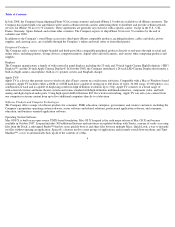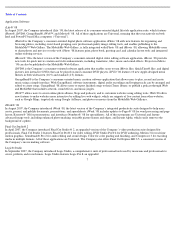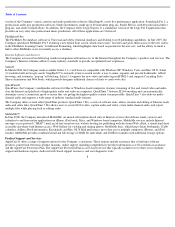Apple 2008 Annual Report Download - page 19
Download and view the complete annual report
Please find page 19 of the 2008 Apple annual report below. You can navigate through the pages in the report by either clicking on the pages listed below, or by using the keyword search tool below to find specific information within the annual report.
Table of Contents
infringe on the Company’s intellectual property, the Company’s ability to maintain a competitive advantage could be negatively affected and
have a materially adverse affect on its financial condition and operating results.
In the market for personal computers and peripherals, the Company faces a significant number of competitors, many of which have broader
product lines, lower priced products, and larger installed customer bases. Consolidation in this market has resulted in larger and potentially
stronger competitors. Price competition has been particularly intense as competitors selling Windows-based personal computers have
aggressively cut prices and lowered product margins. The Company also faces increased competition in key market segments, including
consumer, SMB, education, enterprise, government, and creative markets. An increasing number of Internet devices that include software
applications and are smaller and simpler than traditional personal computers compete for market share with the Company’s existing products.
The Company is currently the only authorized maker of hardware using the Mac OS. The Mac OS has a minority market share in the personal
computer market, which is dominated by makers of computers using competing operating systems, most notably Windows. The Company’s
financial condition and operating results depend substantially on the Company’s ability to continually improve the Mac platform to maintain
design and functional advantages. Use of unauthorized copies of the Mac OS on other companies’ hardware products may result in decreased
demand for the Company’s hardware products, and could materially adversely affect the Company’s financial condition and operating results.
The Company is currently focused on certain mobile communication devices, such as iPhone; consumer electronic devices, including the iPod
family of digital music players, and digital content distribution. The Company faces substantial competition from companies that have
significant technical, marketing, distribution, and other resources, as well as established hardware, software, and digital content supplier
relationships. The Company has only recently entered the mobile communications market, and many of its competitors in the mobile
communications market have significantly greater experience, product breadth, and distribution channels than the Company. The Company also
competes with illegitimate ways to obtain digital content. Because some current and potential competitors have substantial resources and
experience and a lower cost structure, they may be able to provide such products and services at little or no profit or even at a loss. The Company
also expects competition to intensify as competitors attempt to imitate the Company’s approach to providing these components seamlessly
within their individual offerings or work collaboratively to offer integrated solutions.
There can be no assurance the Company will be able to continue to provide products and services that compete effectively.
To remain competitive and stimulate customer demand, the Company must successfully manage frequent product introductions and transitions.
Due to the highly volatile and competitive nature of the personal computer, consumer electronics and mobile communication industries, the
Company must continually introduce new products and technologies, enhance existing products, and effectively stimulate customer demand for
new and upgraded products. The success of new product introductions depends on a number of factors, including timely and successful product
development, market acceptance, the Company’s ability to manage the risks associated with new products and production ramp issues, the
availability of application software for new products, the effective management of purchase commitments and inventory levels in line with
anticipated product demand, the availability of products in appropriate quantities and costs to meet anticipated demand, and the risk that new
products may have quality or other defects in the early stages of introduction. Accordingly, the Company cannot determine in advance the
ultimate effect of new product introductions and transitions on its financial condition and operating results.
The Company faces substantial inventory and other asset risk.
The Company records a write-down for product and component inventories that have become obsolete or exceed anticipated demand or net
realizable value and accrues necessary cancellation fee reserves for orders of excess products and components. The Company also reviews its
long-lived assets for impairment whenever events or changed circumstances indicate the carrying amount of an asset may not be recoverable. If
the Company determines that impairment has occurred, it records a write-down equal to the amount by which the carrying
16
























